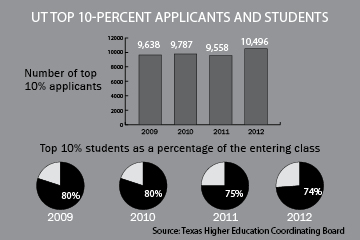The top ten percent rule should be abolished, because it is simply another form of racial discrimination with harmful impacts on higher education.
“In 1997, the Texas Legislature enacted the top ten percent rule after affirmative action was struck down in Hopwood v. Texas,” UT law professor Lino Graglia said.
The rule requires public universities in Texas to automatically admit the top ten percent of every high school in Texas. The intended effect of the rule was to continue racial preference in the admission process through a facially neutral plan, by increasing admission from majority-minority high schools.
The plan was not very well thought out as, soon after the rule was enacted, so many students were automatically admitted to UT that the Texas Legislature capped the number of automatically admitted students at 75 percent of the entering class. Some have called for lowering the cap to 50 percent, but this doesn’t deal with the underlying problem, which is that simply graduating in the top ten percent of a high school does not make a student qualified to attend UT. As reported by the Texas Tribune, the rule creates a mismatch as many of these under-qualified students performed poorly at UT and drop out, whereas, if they had attended a school equal to their college preparedness, they would have performed better
The rule also creates a perverse incentive for students to attend less competitive high schools. A study has shown that many students tend to choose the neighborhood high school in lieu of more competitive magnet schools to improve their chances of being in the top ten percent. This rule is not fair for the students who take harder courses at more competitive high schools to be better prepared for college. Because of this rule, we have students that are admitted to top universities like Stanford, but not UT.
Even prominent supporters of affirmative action, such as UT System Chancellor McRaven, are against the top ten percent rule, because they do not believe it has been effective in increasing diversity.
The Texas Tribune reported that students from poorer majority-minority districts are less likely to attend UT even if they can be automatically admitted, which goes against the intended purpose of the rule. It has also been argued that there is no need for the top ten percent rule when affirmative action has been allowed since the Supreme Court decided Grutter v. Bollinger in 2003.
The only remedy to all the problems with the top ten percent rule is to abolish it. I agree with McRaven that abolishing this rule would make sure the right students are coming to the University, which would put us in the position to be more competitive.
Hung is a second year law student from Brownsville.





















